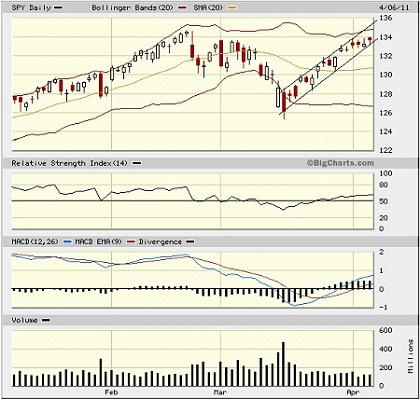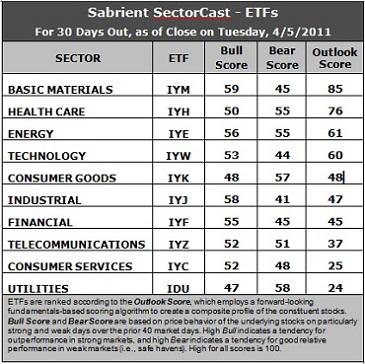As I have been describing over the past several weeks, the SPY chart pattern has been tracking closely to the August-September pattern, and it continues to do so. This week, I’m only showing a 3-month chart so we can see the recent candlesticks more easily. Like August, RSI is back above the neutral line, and MACD has crossed over bullishly, but both are flattening out and could be trying to roll over.

On the bottom of the chart is the daily trading volume, which remains quite weak. You can see that volume is generally much higher on down days. There is also significant overhead resistance at the February highs. Furthermore, you can see that price made an attempt today to break down through the rising channel, which would be a bearish development, and the daily candlestick formed a bearish “hanging man,” which often presages a bearish reversal.
So, although the market is still well positioned for further upside, I anticipate some near-term weakness and a test of support and bullish resolve – perhaps at the 20- or 50-day moving average.
The TED spread (i.e., indicator of credit risk in the general economy, measuring the difference between the 3-month T-bill and 3-month LIBOR interest rates) closed at 24.19 after spiking above 26 on Monday to the highest levels since last August.
Fear as measured by the CBOE market volatility index (VIX) briefly spiked above 31 in mid-March during the initial reports from Japan, but it has since come back down to close today at 16.90, which is well below all of its moving averages and perhaps ready to close the gap (which would be bearish for stocks).
Nevertheless, we remain blessed with an environment of steadily improving economic conditions and corporate profitability, as well as a favorable Fed monetary policy that has kept interest rates and inflation low – all of which provides a favorable environment for U.S. stocks. Traders’ clichés like “The trend is your friend” and “Don’t fight the Fed” have served the bulls well. Also, with the S&P 500 currently priced at around 13x forward earnings, valuations are still attractive from a historical standpoint.
With all of the turmoil and uncertainties in the world today, the risks to continued economic recovery are many, but I would say that the biggest is probably a continued rise in energy and commodity prices.

Latest rankings: The table ranks each of the ten U.S. industrial sector iShares (ETFs) by Sabrient’s proprietary Outlook Score, which employs a forward-looking, fundamentals-based, quantitative algorithm to create a bottom-up composite profile of the constituent stocks within the ETF. In addition, the table also shows Sabrient’s proprietary Bull Score and Bear Score for each ETF.
High Bull score indicates that stocks within the ETF have tended recently toward relative outperformance during particularly strong market periods, while a high Bear score indicates that stocks within the ETF have tended to hold up relatively well during particularly weak market periods. Bull and Bear are backward-looking indicators of recent sentiment trend.
As a group, these three scores can be quite helpful for positioning a portfolio for a given set of anticipated market conditions.
The most notable changes in this week’s Sabrient’s SectorCast rankings are: 1) the increasing strength in Basic Materials (IYM) and Energy (IYE), 2) the steady fall in Technology (IYW), as it now gets only a 60 in its Outlook score, as Wall Street analysts are reining in their optimism a bit in earnings projections, 3) the continued strength in Telecom (IYZ) as it again stays out of the bottom two this week, and 4) the ongoing demise in the Outlook score for Utilities (IDU), which falls into last place with a 24.
Long-dormant Telecom (IYZ) has been a leader in the recent stock market strength, which is reflected in its Outlook score as analysts have finally come around to giving the sector some love and are upgrading their earnings projections.
Basic Materials (IYM) remains on top with an Outlook score of 85. Healthcare (IYH), which has been displaying recent market leadership, holds onto second with a 76 (same as last week). Rising into third place, Energy (IYE) has jumped from an Outlook score of 49 to 61 this week, putting it ahead of sinking Technology (IYW).
Telecom (IYZ) is holding strong with a steadily improving Outlook score of 37, which keeps it well above Consumer Services (IYC) at 25 and Utilities (IDU) with a 24.
Looking at the Bull scores, Basic Materials (IYM) and Industrial (IYJ) have been the strongest during strong markets, followed by Energy (IYE) and Financial (IYF). Utilities (IDU) continues to lag on strong market days, and in fact, IDU and Consumer Goods (IYK) are now the only two with Bull scores below 50.
As for the Bear scores, Utilities (IDU), which has the lowest Bull score, continues to be the favorite “safe haven” sector, followed closely by Consumer Goods (IYK), Energy (IYE), and Healthcare (IYH). Industrial (IYJ), which performs well on strong market days, has by far the lowest Bear score, reflecting quick abandonment by investors on weak market days.
Overall, Basic Materials (IYM) still displays the best combination of the three scores, while Energy (IYE) has the best combination of Bull/Bear. Notably, Energy (IYE) is no longer the only sector scoring above 50 on both Bull and Bear (which reflects positive investor sentiment in all market conditions). Healthcare (IYH) now scores a 50 or better on both metrics, as does resurgent Telecom (IYZ).
Top ranked stocks in Basic Materials and Healthcare include Mercer International (MERC), Kraton Performance Polymers (KRA), Forest Labs (FRX), and Triple-S Management (GTS).
Low ranked stocks in Consumer Services and Utilities include amazon.com (AMZN), MGM Resorts International (MGM), EnerNoc (ENOC), and Energy Recovery, Inc. (ERII).
These scores represent the view that the Basic Materials and Healthcare sectors may be relatively undervalued overall, while Consumer Services and Utilities sectors may be relatively overvalued, based on our 1-3 month forward look.
Disclosure: Author has no positions in stocks or ETFs mentioned.
About SectorCast: Rankings are based on Sabrient’s SectorCast model, which builds a composite profile of each equity ETF based on bottom-up scoring of the constituent stocks. The Outlook Score employs a fundamentals-based multi-factor approach considering forward valuation, earnings growth prospects, Wall Street analysts’ consensus revisions, accounting practices, and various return ratios. It has tested to be highly predictive for identifying the best (most undervalued) and worst (most overvalued) sectors, with a one-month forward look.
Bull Score and Bear Score are based on the price behavior of the underlying stocks on particularly strong and weak days during the prior 40 market days. They reflect investor sentiment toward the stocks (on a relative basis) as either aggressive plays or safe havens. So, a high Bull score indicates that stocks within the ETF have tended recently toward relative outperformance during particularly strong market periods, while a high Bear score indicates that stocks within the ETF have tended to hold up relatively well during particularly weak market periods.
Thus, ETFs with high Bull scores generally perform better when the market is hot, ETFs with high Bear scores generally perform better when the market is weak, and ETFs with high Outlook scores generally perform well over time in various market conditions.
Of course, each ETF has a unique set of constituent stocks, so the sectors represented will score differently depending upon which set of ETFs is used. For Sector Detector, I use ten iShares ETFs representing the major U.S. business sectors.

